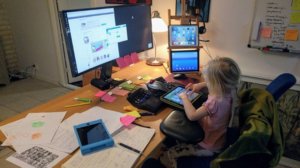Ten years ago, Per Haglund was a product manager for a fintech company in Sweden. While he felt it was a good job to pay the bills, he had very little room to be creative. When smartphones became a part of his work life, Per and his colleagues thought it could be interesting and fun to create apps. With a group of coworkers, he developed his first app and, in his own words, it “flopped completely.” However, Per didn’t let that discourage him, and when his wife got pregnant, he began to create what would become a series of hugely successful apps for children. App Family’s apps are educational and entertaining by design to reach children from ages 1-6. They range from colorful games like jigsaw puzzles and coloring books to educational memory training apps. App Family developed some of these apps in cooperation with educators. Per’s apps are often utilized in helping children with special needs as well.
As a true one-man operation, Per started outsourcing early on by hiring developers, using royalty-free graphics, and then fine-tuning his products himself. Three years after launching App Family, his apps became successful enough that he left his job in the fintech industry and turned his full attention to the creative job that he loves. Now, App Family has 30 apps, and its suite accumulated more than 95 million downloads on the Google Play store and Apple App Store combined. Without a substantial marketing or advertising budget, exclusively using app store optimization, Per has customers all around the world with his biggest markets being Brazil, the United States, and India.

Here’s what a typical day at the App Family office looks like. Per’s daughter is doing some important app testing. Source: Per Haglund
Running his own business allows a lot of freedom and flexibility for Per. He can take care of his household and work when he needs to do so. While he enjoys making children’s apps, it was the ability to provide for his family this way that kept him in the app business. Per provides his apps for free, except for the educational memo app, which is often purchased in bulk by educators. App Family’s apps for children three and under have no ads and only use in-app purchases, while the apps for children three and older generate revenue from ads but have the option to remove them through an in-app purchase.
Without online platforms like Google Play or Apple’s App Store, Per says, he wouldn’t have taken the jump into app development to create educational apps for kids. The app stores are his main way to reach customers, and being part of this successful ecosystem allows his business to thrive. Per is most proud of having created something that people enjoy and want to use, and he is a fitting example of a dynamic developer who’s made the most of the opportunities that the platforms offer. The App Association is proud to have App Family as a member.
